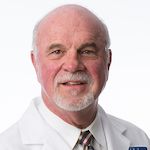Article
Dr. David Law discusses the benefits of InterStim for patients with OAB
Author(s):
"The biggest improvement in my patients has been the urgency frequency and urgency incontinence, and even some of the patients with irritable bowel," says David W. Law, DO.
David W. Law, DO

The InterStim X system, a sacral nerve stimulation therapy, has been recently approved by the FDA to help patients who suffer bladder and bowel control issues. In the following interview, David W. Law, DO, discusses why InterStim has been so “lifestyle-changing” for patients with overactive bladder (OAB) and gives some tips as to how clinicians can best implement the system in their practice. Law was recently awarded a Center of Excellence Designation by Medtronic, the manufacturer of InterStim. He is the chief of surgery at Oakwood Southshore Medical Center in Trenton, Michigan, and clinical professor in the department of urology at the Michigan State University Medical School in East Lansing.
What does being awarded Medtronic's Center of Excellence designation mean to you?
Well, it's been a company that I've been affiliated with since 1997, and they've made tremendous progress in terms of developing a much more improved way of not only capturing the patients that need help, but [also] assisting them. I was quite surprised and honored, obviously, because I'm a firm believer that this is an alternative and a solution to a lot of the patients that have life problems, in terms of their incontinence [and] their ability to socialize. [It] brings them out of the house and gets them sociable again, and it's a life changer. So, I was really honored that they even considered me. But, then again, I'm happy to be a part of this organization.
What is your caseload like in terms of patients treated with InterStim?
We probably address 10 to 12 patients every month with the unit. It's a trial period for 1 week and if they get the results that they want, we go forward. The way we've been doing stage 1 has been so successful that at least 95% of the people go forward with stage 2. I'm no longer doing the [peripheral nerve evaluation] PNE in the office because sometimes that doesn't capture the area that I'm looking for, so I'll do stage 1 in the OR with fluoroscopy, making sure that I have a good placement of the neural probe, and then connect that to an external lead wire. For 1 week, they just trial it, and because of that, I've been much more successful in moving forward with stage 2.
How has the use of InterStim improved your care of patients with OAB?
It's been a lifestyle-changer. I mean, there are people [who] were wearing pads, [who] were socially embarrassed, [who] were actually afraid to socialize or be out in public because of the urgency, frequency, and leakage. And then there's the other segment of patients that were in retention and had to cath themselves or wear a catheter. That group of people have also been successfully treated, not to the same degree that the urgency frequency patients in my practice are, but still there's a significant improvement in being able to urinate without cathing themselves or without using a catheter. But, like I said, the biggest improvement in my patients has been the urgency frequency and urgency incontinence, and even some of the patients with irritable bowel. Some of those patients have actually been able to improve their voiding and their bowel movements, so it's not so socially embarrassing. To me, it's a big game-changer, and they don't have the medications [where] they have to worry about the side effects of dry mouth, constipation, memory loss, and some of the other issues that come along with the anticholinergics. I'm excited. I don't go to it as a first choice; I usually trial the medicines at first. Those patients that don't successfully complete what they consider to be acceptable will go forward then with the trial of the InterStim.
Do you have any pointers or tips/tricks you've picked up along the way regarding the InterStim that you can pass on to other clinicians?
I think the main thing is placement of the neural probe on the first go around. To me, I tried [the PNE] in the office, I tried placing a wire, and many times it wasn't exactly where I wanted to be. One of the reps years ago said to me, "Why don't we just do this in the 1-day surgery center?" And I thought, "Well, that defeated the purpose," but when I started doing the stage 1 in the 1-day surgery center under fluoroscopy, and [placed] the neural probe in the proper position, my conversion rate to stage 2 jumped from about 75% up to about 95%. So, I think that's the tip—if you want to really get involved with InterStim, I'm not a big fan of the PNE, but I'm a big fan of placement of the neural probe initially in the right place so that [the] 1-week trial encourages patients to go forward with stage 2.
Is there anything else you would like to say about receiving this designation?
Just thank you. It's very much appreciated. The company has been very solid, and alternative companies have come around and I think they've only made them better. They went up to the challenge and they improved. We've now got an MRI-compatible unit, which is a huge improvement where patients—especially the MS patients that need their MRIs—can keep the unit in. So, I'm just very excited that the company would even recognize, reach out, and give me that designation and that honor. It's just very exciting to be a part of a company that's made such an improvement in patients' lives. That's what I've always tried to do as a physician—just making people happier, making people more comfortable. This company has allowed me to do that, and I thank them for the recognition and the honor.
















